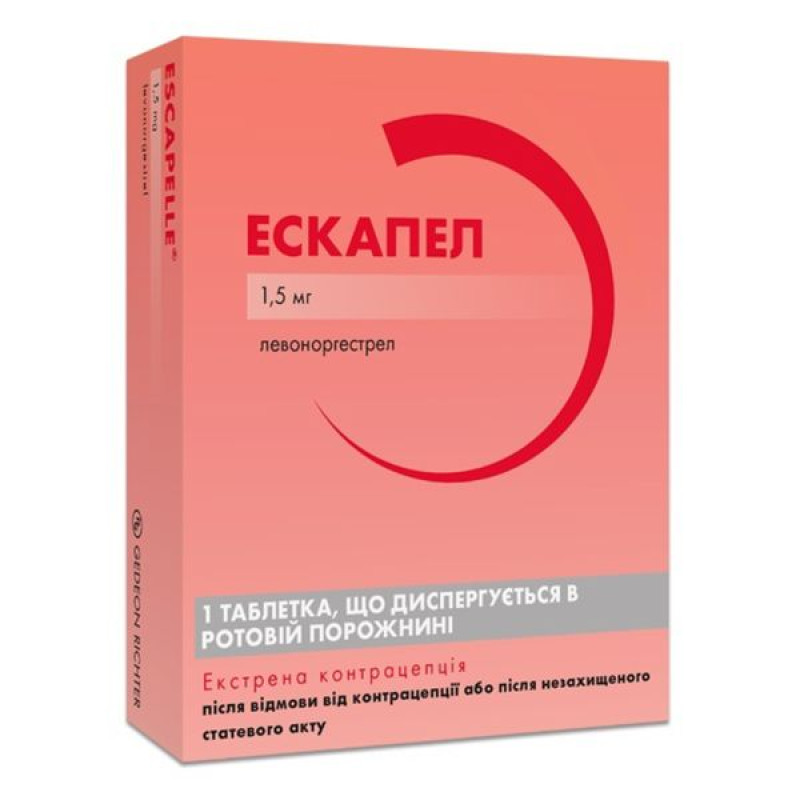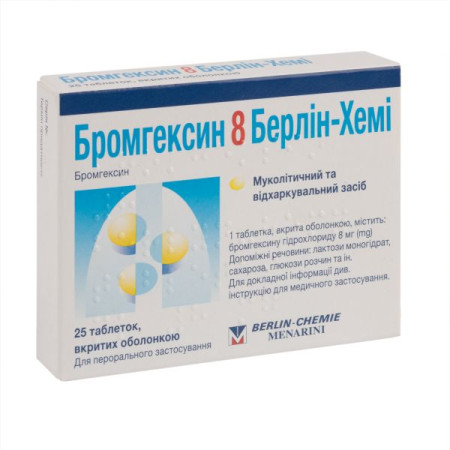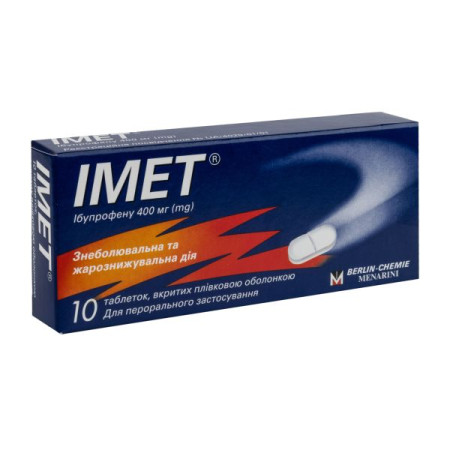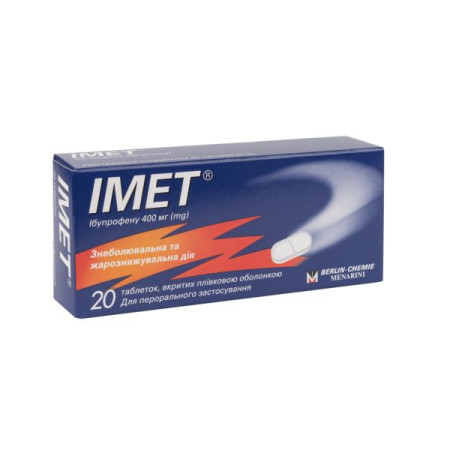Escapel orodispersible tablets 1.5 mg No. 1

Instructions for use Escapel orodispersible tablets 1.5 mg No. 1
Composition
active ingredient: levonorgestrel;
1 orodispersible tablet contains 1.5 mg levonorgestrel;
Excipients: mannitol (E 421), pregelatinized starch, low-substituted hydroxypropylcellulose, crospovidone type B, sodium stearyl fumarate, Opadry orange (hypromellose, titanium dioxide (E 171), sunset yellow FCF (E 110), iron oxide yellow (E 172), indigo carmine (E 132)), colloidal anhydrous silicon dioxide, aspartame (E 951), orange flavor.
Dosage form
Orodispersible tablets.
Main physicochemical properties: pale orange with dark inclusions, round, biconvex tablets with a diameter of 6 mm. One side is engraved with "GC3", the other side is without engraving. With a slight orange odor.
Pharmacotherapeutic group
Sex hormones and modulators of the reproductive system. Emergency contraceptives. ATX code G03A D01.
Pharmacological properties
Pharmacodynamics.
The exact mechanism of action of the drug Escapelle is unknown. At recommended doses, levonorgestrel affects ovulation and fertilization if sexual intercourse occurs in the preovulatory phase of the menstrual cycle, i.e. at the time of the highest probability of fertilization. The drug is not effective if implantation has begun.
Efficacy: A previously conducted clinical trial showed that 750 mcg of levonorgestrel (given as two 750 mcg doses taken 12 hours apart) prevents pregnancy in 85% of cases. It is likely that the longer the time between intercourse and taking the drug, the lower its effectiveness (95% within the first 24 hours, 85% between 24 and 48 hours, and 58% between 48 and 72 hours).
According to the results of a previously conducted clinical trial, 2 levonorgestrel 750 mcg tablets taken at the same time (within 72 hours of unprotected intercourse) prevent pregnancy in 84% of cases. There was no difference in the rate of pregnancy in women who took the drug on the third or fourth day after unprotected intercourse (p > 0.2).
There is limited evidence, which requires further confirmation, on the effect of overweight/high body mass index (BMI) on the contraceptive efficacy of the drug. Three World Health Organization studies showed no trend for reduced efficacy with increasing body weight/BMI (see Table 1), while two other studies showed reduced efficacy with increasing body weight/BMI (see Table 2). Both meta-analyses did not include cases where the drug was taken more than 72 hours after unprotected intercourse (off-label use) and cases where unprotected intercourse occurred after taking the drug.
Table 1
| Indicators | Women with low body weight (BMI 0-18.5 kg/m2) | Women with normal body weight (BMI 18.5−25 kg/m2) | Overweight women (BMI 25-30 kg/m2) | Obese women (BMI ≥ 30 kg/m2) |
| Total number | 600 | 3952 | 1051 | 256 |
| Number of pregnancies | 11 | 39 | 6 | 3 |
| Pregnancy rate | 1.83% | 0.99% | 0.57% | 1.17% |
| Confidence interval | 0.92–3.26 | 0.70–1.35 | 0.21–1.24 | 0.24–3.39 |
Table 2
| Indicators | Women with low body weight (BMI 0-18.5kg/m2) | Women with normal body weight (BMI 18.5-25kg/m2) | Overweight women (BMI 25-30kg/m2) | Obese women (BMI ≥ 30kg/m2) |
| Total number | 64 | 933 | 339 | 212 |
| Number of pregnancies | 1 | 9 | 8 | 11 |
| Pregnancy rate | 1.56% | 0.96% | 2.36% | 5.19% |
| Confidence interval | 0.04–8.40 | 0.44–1.82 | 1.02–4.60 | 2.62–9.09 |
Recommended doses of levonorgestrel do not significantly affect blood clotting factors, fat and carbohydrate metabolism.
Pediatric population
A prospective observational study showed that of 305 women using levonorgestrel pills for emergency contraception, seven became pregnant, giving an overall pregnancy rate of 2.3%. The pregnancy rate in women under 18 years of age (2.6%, or 4 out of 153) was comparable to that in women over 18 years of age (2.0%, or 3 out of 152).
Pharmacokinetics.
When taken orally, levonorgestrel is rapidly and almost completely absorbed.
According to a study involving 16 patients, 2 hours after a single dose of levonorgestrel at a dose of 1.5 mg, the Cmax was 18.5 ng/ml.
After reaching maximum concentration, the level of levonorgestrel in the blood decreases, the average half-life is approximately 26 hours.
Levonorgestrel binds to albumin and sex hormone binding globulin (SHBG). 1.5% of the total amount in blood plasma is in the form of free steroid, 65% is specifically bound to SHBG.
Absolute bioavailability is 100% of the administered dose.
0.1% of the dose of the drug taken enters the baby's body through breast milk.
Indication
For emergency oral contraception in the first 72 hours after sexual intercourse, during which no contraceptive methods were used or the contraceptive method used was not sufficiently reliable.
Contraindication
Hypersensitivity to any of the components of the drug, severe hepatic insufficiency; pregnancy.
Interaction with other medicinal products and other types of interactions
The metabolism of levonorgestrel is increased by concomitant use of inducers of hepatic enzymes, mainly inducers of the CYP3A4 enzyme system. When co-administered with efavirenz, the plasma level of levonorgestrel (AUC) was reduced by approximately 50%.
Medicinal products containing the following active substances may reduce the plasma concentration of levonorgestrel: barbiturates (including primidone); phenytoin; carbamazepine; herbal preparations containing Hypericum perforatum (St. John's wort); rifampicin; ritonavir; rifabutin; griseofulvin.
Women who have taken a liver enzyme inducer within the past 4 weeks and who require emergency contraception should consider using a nonhormonal emergency contraceptive (e.g., a copper-containing intrauterine system). Taking a double dose of levonorgestrel (3000 mcg of levonorgestrel within 72 hours of unprotected intercourse) is an alternative option for women who are unable or unwilling to use a copper-containing intrauterine system, although this specific combination (double dose of levonorgestrel while taking a liver enzyme inducer) has not been studied.
Drugs containing levonorgestrel may increase the toxicity of cyclosporine by inhibiting its metabolism.
Application features
Emergency contraception is intended for emergencies. It does not replace regular contraception in any way. Avoid repeated use of Escapelle tablets during the same menstrual cycle to avoid cycle disruption.
Emergency contraceptives do not prevent pregnancy in all cases. The probability of fertilization is high in cases where the exact time of sexual intercourse is unknown and when more than 72 hours have passed since the moment of unprotected sexual intercourse for the period of one menstrual cycle. In such cases, taking the Escapelle tablet after the second sexual intercourse will not bring the desired result. If menstruation is delayed for more than 5 days, as well as in the case when menstruation has come on time, but is unusual or there is a suspicion of pregnancy for any other reason, a gynecological examination should be performed to exclude the presence of pregnancy, including ectopic pregnancy. The absolute risk of ectopic pregnancy is likely to be low, since levonorgestrel prevents ovulation and fertilization. Ectopic pregnancy may continue despite the occurrence of uterine bleeding. If pregnancy occurs after use of Escapelle tablets, the possibility of ectopic pregnancy should be considered, especially in women presenting with abdominal/pelvic pain or collapse and who have a history of ectopic pregnancy, pelvic surgery or inflammation.
Therefore, levonorgestrel is not recommended for use in women at risk of developing ectopic pregnancy (history of salpingitis or ectopic pregnancy).
In case of severe liver dysfunction, the use of Escapelle tablets is contraindicated.
Severe malabsorption in the digestive tract (for example, Crohn's disease) reduces the effectiveness of the contraceptive drug.
The use of the drug usually does not disrupt the regularity and normal nature of menstruation. However, sometimes premature onset of menstruation or its delay is possible. After using the Escapel tablet, it is recommended to consult a doctor for selection or correction of regular contraception. If Escapel was used due to errors made in regular hormonal contraception, and menstruation does not begin within the corresponding seven-day break, pregnancy should be excluded.
There are limited data that require further confirmation that the contraceptive efficacy of Escapelle may decrease with increasing body weight or body mass index (BMI) of the patient (see section "Pharmacodynamics"). If necessary, a woman, regardless of her body weight and BMI, should take emergency contraception as soon as possible after unprotected intercourse.
Compared to regular contraceptives, Escapelle tablets are less effective. Women who frequently use emergency contraception should consult their doctor to choose a regular contraceptive method.
Emergency contraception does not replace the need for protection against sexually transmitted diseases.
This medicinal product contains 0.8 mg of aspartame (E 951) in each orodispersible tablet. After oral administration, aspartame is hydrolyzed in the gastrointestinal tract. One of the main hydrolysis products is phenylalanine, which may be harmful to people with phenylketonuria (PKU).
This medicinal product contains less than 1 mmol sodium (23 mg) per orodispersible tablet, i.e. essentially ‘sodium-free’.
Use during pregnancy or breastfeeding
Pregnancy. Taking Escapelle tablets during pregnancy is contraindicated. The drug does not cause abortion. According to epidemiological studies in the case of pregnancy that occurred against the background of the use of emergency contraception, the drug does not have an undesirable effect on the fetus, but there is no clinical data on the possible consequences of taking levonorgestrel in doses exceeding 1.5 mg.
Breastfeeding. Levonorgestrel passes into breast milk. The potential exposure of the infant to levonorgestrel can be reduced by taking the drug immediately after breastfeeding or by refraining from breastfeeding for 8 hours after taking the drug.
Fertility: Levonorgestrel increases the possibility of menstrual irregularities, which in some cases lead to earlier or later ovulation. These changes may affect the dates of the fertile period, but there is no information on fertility with long-term follow-up.
Ability to influence reaction speed when driving vehicles or other mechanisms
Studies of the possible effect on the ability to drive vehicles or other mechanisms have not been conducted.
Method of administration and doses
Method of application
For oral use.
The orodispersible tablet should be squeezed out of the blister with dry hands and placed on the tongue, where it will dissolve and can be swallowed with saliva.
The orodispersible tablet can be used even in circumstances where liquid is not available.
Dosage
1 tablet should be taken as soon as possible after unprotected intercourse, preferably within the first 12 hours and no later than 72 hours (see section "Pharmacodynamics").
Women who have taken liver enzyme inducers within the last 4 weeks and who require emergency contraception are recommended to use non-hormonal contraceptives (e.g. a copper-containing intrauterine system). If a woman is unable or unwilling to use a copper-containing intrauterine system, a double dose of levonorgestrel (2 tablets taken as a single dose) is recommended (see section 4.5).
If vomiting occurs within 3 hours after taking the tablet, you must take 1 more tablet.
Escapelle, an orodispersible tablet, can be taken on any day of the menstrual cycle, provided that the previous menstruation was normal.
After emergency contraception, it is recommended to use a local barrier method (e.g. condoms, diaphragms, spermicide, cervical cap) until the start of the next menstruation. The use of Escapelle orodispersible tablet is not a contraindication to the continuation of regular oral hormonal contraceptive use.
Children.
Escapelle, an orodispersible tablet, is not intended for use in prepubertal children for emergency contraception.
Overdose
There are no data on severe adverse reactions after taking large doses of the drug. Overdose may cause nausea and withdrawal bleeding. There is no specific antidote, treatment is symptomatic.
Side effects
The most common adverse effect of Escapelle was nausea.
Table 3
| MedRA 16.0 System Organ Class | Adverse reactions by frequency | |
| very common (≥ 10%) | common (≥ 1% - < 10%) | |
| From the nervous system | headache | dizziness |
| Gastrointestinal tract | nausea, lower abdominal pain | diarrhea, vomiting |
| From the reproductive system and mammary glands | bleeding that is not related to menstruation | Delayed menstruation for more than 7 days, irregular menstruation, breast engorgement |
| Systemic disorders | increased fatigue |
A temporary change in the nature of menstruation is possible. In most women, menstrual irregularities occur within 5 days. If menstruation is delayed for more than five days, pregnancy should be excluded.
During post-marketing surveillance, the following additional adverse reactions were observed:
from the gastrointestinal tract:
rare (< 1/10,000): abdominal pain;
from the skin and subcutaneous tissue:
rare (< 1/10,000): rash, urticaria, itching;
from the reproductive system and mammary glands:
rare (< 1/10,000): pelvic pain, dysmenorrhea;
systemic disorders:
rare (< 1/10,000): facial edema.
Reporting adverse reactions after registration of a medicinal product is important. This allows monitoring of the benefit/risk ratio of the medicinal product. Medical and pharmaceutical professionals, as well as patients or their legal representatives, should report all cases of suspected adverse reactions and lack of efficacy of the medicinal product via the automated pharmacovigilance information system at the following link: https://aisf.dec.gov.ua/.
Expiration date
2 years.
Storage conditions
Store in the original packaging to protect from moisture. Keep out of the reach of children.
Packaging
1 tablet in a blister. 1 blister in a laminated aluminum foil bag; 1 bag in a cardboard box.
Vacation category
According to the recipe.
Producer
JSC "Gedeon Richter".
Location of the manufacturer and its address of the place of implementation of the activity.
H-1103, Budapest, Demrei Street 19-21, Hungary.
There are no reviews for this product.
There are no reviews for this product, be the first to leave your review.
No questions about this product, be the first and ask your question.







